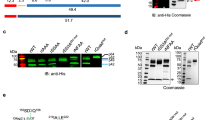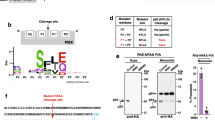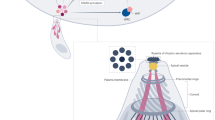Abstract
Plasmodium falciparum causes the virulent form of malaria and disease manifestations are linked to growth inside infected erythrocytes. To survive and evade host responses the parasite remodels the erythrocyte by exporting several hundred effector proteins beyond the surrounding parasitophorous vacuole membrane. A feature of exported proteins is a pentameric motif (RxLxE/Q/D) that is a substrate for an unknown protease. Here we show that the protein responsible for cleavage of this motif is plasmepsin V (PMV), an aspartic acid protease located in the endoplasmic reticulum. PMV cleavage reveals the export signal (xE/Q/D) at the amino terminus of cargo proteins. Expression of an identical mature protein with xQ at the N terminus generated by signal peptidase was not exported, demonstrating that PMV activity is essential and linked with other key export events. Identification of the protease responsible for export into erythrocytes provides a novel target for therapeutic intervention against this devastating disease.
This is a preview of subscription content, access via your institution
Access options
Subscribe to this journal
Receive 51 print issues and online access
$199.00 per year
only $3.90 per issue
Buy this article
- Purchase on Springer Link
- Instant access to full article PDF
Prices may be subject to local taxes which are calculated during checkout




Similar content being viewed by others
References
Snow, R. W. et al. The global distribution of clinical episodes of Plasmodium falciparum malaria. Nature 434, 214–217 (2005)
Miller, L. H., Good, M. F. & Milon, G. Malaria pathogenesis. Science 264, 1878–1883 (1994)
Raventos-Suarez, C., Kaul, D. K., Macaluso, F. & Nagel, R. L. Membrane knobs are required for the microcirculatory obstruction induced by Plasmodium falciparum-infected erythrocytes. Proc. Natl Acad. Sci. USA 82, 3829–3833 (1985)
Barnwell, J. W. et al. A human 88-kD membrane glycoprotein (CD36) functions in vitro as a receptor for a cytoadherence ligand on Plasmodium falciparum-infected erythrocytes. J. Clin. Invest. 84, 765–772 (1989)
Marti, M. et al. Targeting malaria virulence and remodeling proteins to the host erythrocyte. Science 306, 1930–1933 (2004)
Hiller, N. L. et al. A host-targeting signal in virulence proteins reveals a secretome in malarial infection. Science 306, 1934–1937 (2004)
Pei, X. et al. Structural and functional studies of interaction between Plasmodium falciparum knob-associated histidine-rich protein (KAHRP) and erythrocyte spectrin. J. Biol. Chem. 280, 31166–31171 (2005)
Baruch, D. I. et al. Cloning the P. falciparum gene encoding PfEMP1, a malarial variant antigen and adherence receptor on the surface of parasitized human erythrocytes. Cell 82, 77–87 (1995)
Su, X. Z. et al. The large diverse gene family var encodes proteins involved in cytoadherence and antigenic variation of Plasmodium falciparum-infected erythrocytes. Cell 82, 89–100 (1995)
Smith, J. D. et al. Switches in expression of Plasmodium falciparum var genes correlate with changes in antigenic and cytoadherent phenotypes of infected erythrocytes. Cell 82, 101–110 (1995)
Maier, A. G. et al. Exported proteins required for virulence and rigidity of Plasmodium falciparum-infected human erythrocytes. Cell 134, 48–61 (2008)
Maier, A. G., Cooke, B. M., Cowman, A. F. & Tilley, L. Malaria parasite proteins that remodel the host erythrocyte. Nature Rev. Microbiol. 7, 341–354 (2009)
de Koning-Ward, T. F. et al. A newly discovered protein export machine in malaria parasites. Nature 459, 945–949 (2009)
Sargeant, T. J. et al. Lineage-specific expansion of proteins exported to erythrocytes in malaria parasites. Genome Biol. 7, R12 (2006)
van Ooij, C. et al. The malaria secretome: from algorithms to essential function in blood stage infection. PLoS Pathog. 4, e1000084 (2008)
Chang, H. H. et al. N-terminal processing of proteins exported by malaria parasites. Mol. Biochem. Parasitol. 160, 107–115 (2008)
Boddey, J. A., Moritz, R. L., Simpson, R. J. & Cowman, A. F. Role of the Plasmodium export element in trafficking parasite proteins to the infected erythrocyte. Traffic 10, 285–299 (2009)
Przyborski, J. M. et al. Trafficking of STEVOR to the Maurer’s clefts in Plasmodium falciparum-infected erythrocytes. EMBO J. 24, 2306–2317 (2005)
Weber, I. T. et al. Molecular modeling of the HIV-1 protease and its substrate binding site. Science 243, 928–931 (1989)
Miller, M. et al. Structure of complex of synthetic HIV-1 protease with a substrate-based inhibitor at 2.3 Å resolution. Science 246, 1149–1152 (1989)
Waller, R. F., Reed, M. B., Cowman, A. F. & McFadden, G. I. Protein trafficking to the plastid of Plasmodium falciparum is via the secretory pathway. EMBO J. 19, 1794–1802 (2000)
Bozdech, Z. et al. The transcriptome of the intraerythrocytic developmental cycle of Plasmodium falciparum . PLoS Biol. 1, e5 (2003)
Le Roch, K. G. et al. Discovery of gene function by expression profiling of the malaria parasite life cycle. Science 301, 1503–1508 (2003)
Klemba, M. & Goldberg, D. E. Characterization of plasmepsin V, a membrane-bound aspartic protease homolog in the endoplasmic reticulum of Plasmodium falciparum . Mol. Biochem. Parasitol. 143, 183–191 (2005)
La Greca, N. et al. Identification of an endoplasmic reticulum-resident calcium-binding protein with multiple EF-hand motifs in asexual stages of Plasmodium falciparum . Mol. Biochem. Parasitol. 89, 283–293 (1997)
Knuepfer, E., Rug, M. & Cowman, A. F. Function of the Plasmodium export element can be blocked by green fluorescent protein. Mol. Biochem. Parasitol. 142, 258–262 (2005)
Carlton, J. M. et al. Comparative genomics of the neglected human malaria parasite Plasmodium vivax . Nature 455, 757–763 (2008)
Pain, A. et al. The genome of the simian and human malaria parasite Plasmodium knowlesi . Nature 455, 799–803 (2008)
Meissner, M. et al. Tetracycline analogue-regulated transgene expression in Plasmodium falciparum blood stages using Toxoplasma gondii transactivators. Proc. Natl Acad. Sci. USA 102, 2980–2985 (2005)
Baum, J. et al. A malaria parasite formin regulates actin polymerization and localizes to the parasite-erythrocyte moving junction during invasion. Cell Host Microbe 3, 188–198 (2008)
Gilson, P. R. et al. MSP119 miniproteins can serve as targets for invasion inhibitory antibodies in Plasmodium falciparum provided they contain the correct domains for cell surface trafficking. Mol. Microbiol. 68, 124–138 (2008)
Duraisingh, M. T., Triglia, T. & Cowman, A. F. Negative selection of Plasmodium falciparum reveals targeted gene deletion by double crossover recombination. Int. J. Parasitol. 32, 81–89 (2002)
Hodder, A. N. et al. Structural insights into the protease-like antigen Plasmodium falciparum SERA5 and its noncanonical active-site serine. J. Mol. Biol. 392, 154–165 (2009)
Dyrløv Bendtsen, J., Nielsen, H., von Heijne, G. & Brunak, S. Improved prediction of signal peptides: SignalP 3.0. J. Mol. Biol. 340, 783–795 (2004)
Acknowledgements
We thank the Australian Red Cross Blood Bank for the provision of human blood and serum, the AIDS Research and Reference Reagent Program, Division of AIDS, NIAID, NIH for providing HIV protease inhibitors and MR4 (ATCC) for plasmepsin V antibodies, contributed by D. Goldberg. This work was supported by the National Health and Medical Research Council, and a grant from the National Institutes of Health (RO1 AI44008). J.A.B. is an NHMRC Peter Doherty postdoctoral Fellow and A.F.C. is an International Research Scholar of the Howard Hughes Medical Institute and an Australia Fellow.
Author Contributions J.A.B. performed the biochemical and cell biological experiments. A.N.H. performed HPLC, biochemical analysis and purification of recombinant plasmepsin V. S.G. made 3D7-PMIXHA, purified recombinant GBP130 proteins and analysed their processing. H.P. and E.A.K. performed the proteomics analysis. T.F.d.K.-W. attempted the knockouts of plasmepsin V in P. berghei and analysed the results. A.F.C. designed and interpreted experiments. All authors contributed to the study design and to writing the manuscript.
Author information
Authors and Affiliations
Corresponding author
Ethics declarations
Competing interests
The authors declare no competing financial interests.
Supplementary information
Supplementary Information
This file contains detailed Figure Legends for Supplementary Figures 1-4, Supplementary Figures 1-7 with Legends and Supplementary References. (PDF 4315 kb)
Rights and permissions
About this article
Cite this article
Boddey, J., Hodder, A., Günther, S. et al. An aspartyl protease directs malaria effector proteins to the host cell. Nature 463, 627–631 (2010). https://doi.org/10.1038/nature08728
Received:
Accepted:
Issue Date:
DOI: https://doi.org/10.1038/nature08728
This article is cited by
-
Toxoplasma protein export and effector function
Nature Microbiology (2024)
-
Tryptophan C-mannosylation is critical for Plasmodium falciparum transmission
Nature Communications (2022)
-
Maturation and substrate processing topography of the Plasmodium falciparum invasion/egress protease plasmepsin X
Nature Communications (2022)
-
Click Inspired Synthesis of Novel Cinchonidine Glycoconjugates as Promising Plasmepsin Inhibitors
Scientific Reports (2020)
-
The parasitophorous vacuole of the blood-stage malaria parasite
Nature Reviews Microbiology (2020)
Comments
By submitting a comment you agree to abide by our Terms and Community Guidelines. If you find something abusive or that does not comply with our terms or guidelines please flag it as inappropriate.



